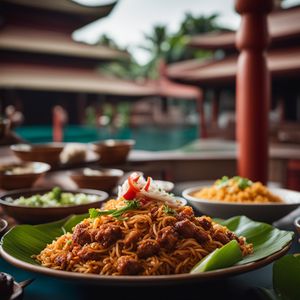
Dish
Saksang
Saksang is a dish that is made with pork that is cooked in a spicy sauce made with a variety of spices, including turmeric, ginger, and lemongrass. The dish is typically served with rice and is a favorite among many Indonesians. The dish is known for its spicy and tangy flavor, which is a result of the tamarind that is used in the sauce. The dish is also known for its tender and juicy pork, which is a result of the slow cooking process.
Origins and history
Saksang is a dish that has been around for centuries. It is believed to have originated from the Batak people of North Sumatra. The dish was traditionally served during special occasions, such as weddings and funerals. Today, it is a popular dish in many Indonesian restaurants around the world.
Dietary considerations
Saksang is a dish that is high in protein and low in carbohydrates. It is also a good source of iron and vitamin C. However, the dish is not suitable for people who are allergic to pork or who have a sensitivity to spicy foods.
Variations
There are many variations of Saksang, including versions that use beef or chicken instead of pork. Some versions also use coconut milk in the sauce to make it creamier. The dish can also be made less spicy by reducing the amount of chili peppers that are used.
Presentation and garnishing
Saksang is typically served in a bowl with a spoon. The dish is garnished with chopped scallions and cilantro. Some people also like to add a squeeze of lime juice to the dish.
Tips & Tricks
To make the dish less spicy, you can reduce the amount of chili peppers that are used. You can also add more coconut milk to the sauce to make it creamier. If you want to make the dish more flavorful, you can add more ginger and lemongrass to the sauce.
Side-dishes
Saksang is typically served with rice, but it can also be served with noodles or bread. Some people also like to serve it with pickled vegetables or a simple salad.
Drink pairings
Saksang pairs well with a cold beer or a glass of red wine. The beer helps to cut through the spiciness of the dish, while the wine complements the flavors of the sauce.
Delicious Saksang recipes
More dishes from this category... Browse all »

Aab gosht
Indian cuisine

Abgoosht
Iranian cuisine

Adobo
Filipino cuisine

Adobo sa gatâ
Filipino cuisine

Adobong baboy
Filipino cuisine

Adobong baka
Filipino cuisine

Adobong dilaw
Filipino cuisine

Adobong hito
Filipino cuisine
More cuisines from this region... Browse all »

Balinese cuisine
Spicy, Sweet, Savory

Banjar cuisine
Spicy, Flavorful, Savory, Sour

Indo cuisine
Spicy, Sweet, Savory

Indonesian Arab cuisine
Spicy, Savory, Sweet

Indonesian Chinese cuisine
Salty, Savory, Spicy, Umami, Sweet

Indonesian Indian cuisine
Spicy, Aromatic, Sweet, Sour

Javanese cuisine
Sweet, Savory, Spicy, Umami

Makassar cuisine
Bold, Spicy, Aromatic, Umami

